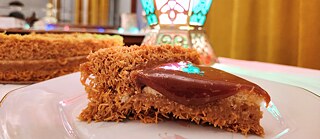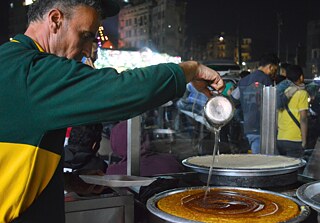There are many creation myths surrounding the Middle East’s iconic dessert, kunafa. The traditional dish is craved year-round, but is exceptionally in high demand during Muslims' holy month. Nadine Tag dives into its history, new trends and how the recent economic crisis is affecting this loved dish.
Picture this. It’s the seventh, twelfth or perhaps the fifteenth century in Damascus, Kufa, Cairo or Istanbul. A turbaned, bearded Caliph in flowing silk-embroidered fine wool robes, languidly rests on a throne of intricately carved wood; calligraphy with verses from the Quran carefully chosen to reflect his humility to Allah and power over his subjects.But he is hungry. It’s Ramadan. He fasts from dawn to sunset.
The hungry Caliph orders his physicians to come up with foods to keep him full; something he can eat at suhoor, the pre-dawn meal, to keep him going through the day.
Kunafa is born.
According to food artisan and author, Dima Sharif, this is one of many creation myths surrounding the Middle East’s iconic dessert, kunafa. The delectable symphony of butter-coated shreds of filo pastry baked to heavenly crunchiness, drenched in syrup, and stuffed with nuts, dollops of cream, mild cheese, or both, is a traditional dish craved year-round, but is exceptionally in high demand during Muslims' holy month.
Consumed post-iftar (the main evening meal) or as a late-night snack to make up for the sugar-shortage during the day, kunafa is more than just a Ramadan staple, for many it’s a matter of identity, principle and intense debate.
For nearly two decades, Egyptian pastry chefs have been committing what some consider to be blasphemy. With the rise of every Ramadan crescent, an annual trend would bring a new ingredient to the cherished dessert, making it the focus of discussions during family gatherings and nightly outings on preferences and flavours.
This Ramadan, as kunafa-lovers in the Arab world’s most populous nation grapple with Egypt’s worst economic crisis in decades, family discussions will revolve around the affordability of keeping the kunafa trend that has localised the dessert for Egypt’s market but made it unaffordable to many.
A Step Back
While some scholars believe kunafa was concocted during the Abbasid Caliphate (750-1258), others argue that it goes either further back to the Umayyad Caliphate (661-750) or further forward to the Ottoman period from 1300 – 1922.But Daniel Newman, head of Arabic Studies at Durham University in the UK, whose research covers Arab food history, is convinced the coveted dessert has its roots in 14th-15th century Egypt somewhere between the Mameluke and Ottoman periods.
“I believe kunafa is Egyptian in origin,” Newman said, adding that the origin of the word ‘kunafa’ is the Coptic word ‘kenefiten,’ which he describes as a kind of ‘cake’ or ‘loaf’.
He explains that the medieval version of kunafa, found in recipe books dating back to the 13th century, was made of very thin flatbread, entirely different from the way modern Egyptians make it today.
Award-winning Iraqi food writer and researcher Nawal Nasrallah agrees.
“Kunafa was made of very thin discs of dough, ten or more, layered on top of each other, rolled, and cut finely into shreds. It would then be moistened with sesame oil or rose water, then fried or cooked and dipped in syrup,” Nasrallah told Ruya.
However, modern kunafa as Egyptians know it, she adds, is made of a thin batter, dropped on a hot plate, turning it into a crust.
Several unique versions of the sweet dish have been created over the years in Egypt. Every Ramadan, local pastry shops blend different ingredients into the historical dessert.
The Kunafa Wars
To many across the Middle East, modern-day variations on this classic treat are an act of sacrilege, a brazen desecration of the sanctity of kunafa. People from Nablus, a historic city in Palestine, for instance, take pride in the fact that the popular, bright orange-blossom-drizzled version of kunafa is named after their city.It is no wonder the annual “innovations” trending every Ramadan happen nowhere near the Levant.
The first ever modification was introduced in 2008 by a local patisserie. As Ramadan that year coincided with the harvesting season of Egypt’s succulent mangoes, the patisserie’s chef added bits of the fruit on top of the syrup-drenched, butter-soaked shreds of golden filo pastry.
People liked it, and the rest was history.
The mango-topping gave way to Nutella, then lotus cream, red velvet, marshmallow, nougat. Some chefs even doused kunafa in hibiscus tea or cola.
The secret of kunafa, says Barsoum, is in the syrup.
“Sweet but not too sugary,” he says. “Some people add lemon juice or mellow elements like a light cheese or cream to balance out the sweetness. This doesn’t change the authenticity of kunafa, it helps you soak in the flavor even more. But when you add chocolate with its extremely aggressive taste, it dilutes the genuine subtle, delicate flavor.”
Will the dollar save kunafa?
The good news is, Barsoum’s anxiety over the identity of kunafa may be over sooner than anticipated.To Egyptians, the yearly viral kunafa make-overs are becoming increasingly difficult to keep up with. A deteriorating economy, a foreign currency crisis and the Central Bank’s decision last year to devalue the Egyptian pound, which shed almost 40% of its value against the US dollar, have rendered “fancy” kunafa well beyond the reach of many, as the lack of foreign currency has destabilized trade and made it hard to import.
“We might be forced to let go of the Lotus cream and Nutella, because of how expensive and inaccessible they’ve become,” said Barsoum, but he wasn’t complaining.
In February 2025, the cost of food dropped by 20.08 percent after it surged by 50.90 percent to the corresponding month the year before, while it was estimated by 20.03 percent in December 2024. Food inflation averaged 17.81 percent from 2010 until 2024, to reach an all-time high of 73.60 percent in September of 2023.
“Even the basic kunafa with some nuts has become too expensive, and making it at home is just as costly,” 37-year-old English teacher Mariam Ibrahim, told Ruya.
“Butter or ghee may not be affordable for families who make minimum wage. The same goes for pistachios and hazelnuts. Even making the syrup needs sugar, which used to cost EGP 3 per kilo in 2016, but has now skyrocketed to roughly around EGP 32 to 39,” said Ibrahim.
“During Ramadan in Egypt, there’s higher demand for food items” economist Ali El Edrisi told Ruya. “This inevitably leads to price hikes despite government measures to increase supply and regulate prices.”
But he says the hikes will lead people to consider alternatives or cut consumption altogether.
Enas Hamza, a 57-year-old housewife, sees a silver lining.
“Instead of organic ghee, we can use plant-based ghee, instead of cashews, pistachios, or walnuts, we can add peanuts. Kunafa is important to Egyptians. We will always find a way,” she says.
This piece was published in collaboration with Egab.
* This article was last updated on 5 March 2025
March 2024




